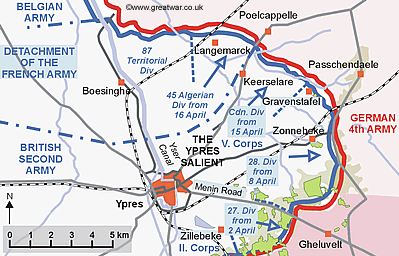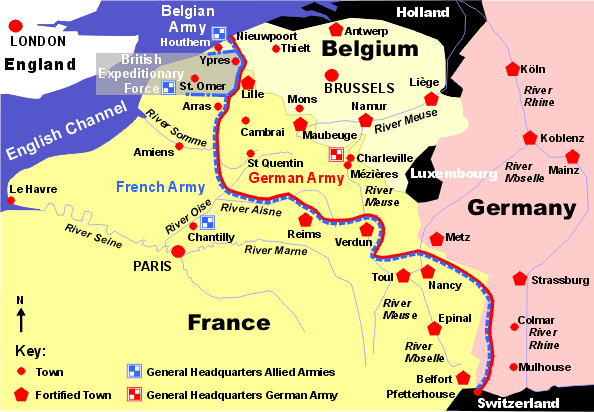 British troops take over from the French Army
British troops take over from the French Army
2 April 1915
Extension of the British Front in the Ypres Salient

In early February the 27th and 28th Divisions of the British Army had taken over the French held sector from St. Eloi to the Ypres-Menin Road.
During the first three weeks of April, from 2nd to 17th April, the British Second Army extended its front again to take over 8 kilometres (five miles) of the French front north of the Ypres-Menin Road as far as the Ypres-Poelcappelle road to the north-east of Ypres. The French XX. Corps currently holding this area was under orders to move to another part of the French battlefront, namely the French Tenth Army sector at Arras (see map below at 'Extension of the British Line').
By 17th April the British divisions holding the line in the Ypres Salient would be in position (from south to north):
- from 2nd to 8th April: the British 27th Division in the Zillebeke area south of the Ypres-Menin Road.
- from 8th to 11th April: the British 28th Division from north of the the Ypres-Menin Road as far as one kilometre west of Gravenstafel.
- from 15th to 17th April: the 1st Canadian Division from the west of Gravenstafel to the Poelcappelle-Keerselare road.
45th Algerian Division Relieves Part of the French 11th Division
On 16th April the 45th Algerian Division, under the command of General Quiquandon, took over what remained of the sector held by the French 11th Division (commanded by General Ferry). By order of General Foch the 45th Algerian Division had begun its move from the Arras sector of the French Tenth Army on 4th April. In the Ypres sector they were now on the left of the 1st Canadian Division.
The Algerian 91st Brigade moved into the front line. 90th Brigade remained in reserve at the divisional billets near Boesinghe. Personal accounts from the incoming Zouaves of the division described feelings of horror as the dawn of their first day in the front line revealed scattered decomposing corpses around them. No-man's-land was also littered with German unburied dead from the fighting of several months ago. They discovered that the trenches they were now occupying were in a bad state and were not continuous.(1)
Crucial Timing of the Algerian Relief
Relief orders for the two Algerian brigades in the Langemarck sector were to alternate their duties between the front line and army reserve (at Crombeke and Westvleteren), with each brigade relieving the other every 8 days.
As 91st Brigade was the first to take over the line when the division arrived in the sector from 16th April, their first scheduled relief was ordered by General Quiquandon to take place during the night of 21st-22nd April, when the 90th Brigade was to move into the line in their place.(2)
This timing of the brigade reliefs was unfortunate for the French. During the morning and afternoon of 22nd April, the actual date of the German gas attack, the Algerian troops of 90th Brigade would not only be settling in to a new trench position but would be spending their first hours in a new battlefront. They had also not served together with the troops of their neighbouring divisions, the French territorial division on their left and the Canadian division on their right.
Extension of the British Line from 30 to 48 Kilometres

With the completion of the relief of the French 11th Division by 1st Canadian Division the British Expeditionary Force had extended their commitment along the Allied front line from 30 to 48 kilometres (19 miles to 30 miles). The northern end of the extended British front line was then located at the Ypres-Poelcappelle road north-east of Ypres in Flanders. The southern end was at Cuinchy on the south side of the La Bassée canal (south-west of Lille) in Artois.(3)
An Unexpected Advantage for the Germans
The German attack on the northern part of the Allied-held Ypres Salient had been planned and prepared for some weeks already. Because of the new secret gas weapon, its launch was conditioned by the direction of the wind. Nevertheless, the change-over of the three British divisions and one French division from the beginning of April was an unexpected bonus. The Germans did not interfere with them as they took over their new sectors. This was most likely because they did not wish to draw attention to any part of the German front line prior to the gas attack.
On the front selected for the main thrust of the German attack on the northern part of the Allied Ypres Salient, two of the three Allied divisions were new to the area, i.e. the 45th Algerian Division and the 1st Canadian Division. It was a favourable consideration for the Germans that these Allied troops would be unfamiliar not only with the ground in their new sector, but may not have experience of fighting next to one another either. The junction of the French and British forces at the Algerian and Canadian divisions was considered to be a possible weak point in the Allied line.
Next>> German Fourth Army issues Operational Orders
Acknowledgements
(1) British Military Operations: France and Belgium 1915
(2) Les Armées Françaises dans la Grande Guerre, Annexe no. 1397